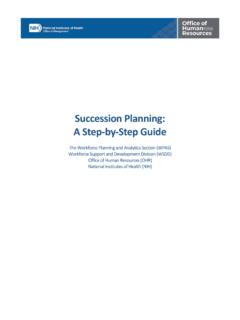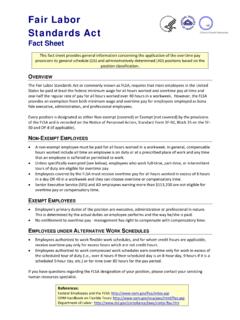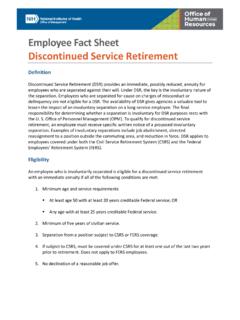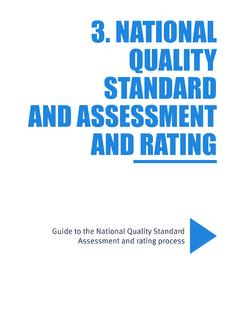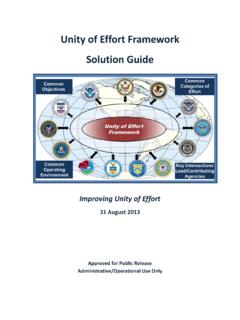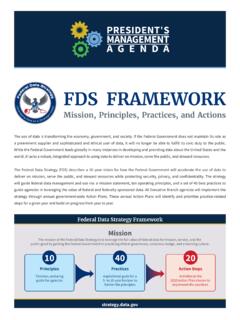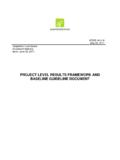Transcription of Competency Implementation Guide
1 Competency Implementation Guide Purpose of This Tool: This tool will assist you with understanding and implementing competencies in your organization. The tool will: Introduce you to competencies Definition of a Competency Anatomy of a Competency Benefits of using competencies in your organization Competency types Explain how to implement and use competencies in your organization for learning and development purposes 2. Competencies, A General Overview 3. General Overview: What are Competencies? Competencies - encompass knowledge, skills, and abilities (KSAs) combined with relevant personal characteristics to successfully perform in your job/role.
2 WHAT. Technical ..you need to know HOW Behavioral ..you apply what you know Competencies describe the observable, measurable, key behaviors or actions that can be seen when a job is being done. 4. General Overview: Anatomy of a Competency A Competency has three parts: Title, Definition, Key Behaviors. Title: Definition: Customer Demonstrates a commitment to public service; serves and satisfies Service internal and external customers; holds self accountable for quality outcomes. Key Behaviors: Establishes and maintains credibility with the public, partners, customers, and co-workers.
3 Works with customers to assess their needs. Takes specific actions to meet/exceed customer requirements and expectations. Conveys a positive attitude when interacting with customers and staff. Identifies opportunities to improve customer service and satisfaction. Key behaviors are examples of observable actions that an employee could be expected to demonstrate in successfully performing his/her work. 5. General Overview: Benefits of Using Competencies in your Organization Competencies offer multiple benefits to an organization and its workforce. Benefit How?
4 Provides a common language for describing workforce needs as they relate to the mission and Define Capabilities strategic objectives of the organization. Establishes and communicates expectations for the specific behaviors that contribute to successful Clarify Expectations job performance. Encourages employees to be accountable for their professional development; Focuses learning on Support learning clearly identified development needs. Provides a baseline and opens the door for professional development and performance conversations Improve Conversations between employees and supervisors.
5 Identify Realistic Goals Identifies strategic, targeted and realistic learning and development objectives/needs. Promotes understanding of the competencies expected for a move into a new job; including Increase Awareness becoming supervisors/managers or changing careers. Identifies strategic, targeted and realistic learning and development objectives/needs to support a Sustain the Organization strongly sustaining organization with a defined succession strategy. Managers can use Competencies to: Support Management of Identify minimum requirements for new hires (interviewing tool); Articulate and standardize Employees expectations; Capture knowledge from retiring employees; and Focus staff on selected aspects of (Manager's Toolkit).
6 Performance to achieve the mission and organization's objectives. 6. General Overview: Additional Benefits of Competencies Benefits for the Organization: Ensures that organization-funded training and professional development activities are cost-effective, goal-oriented, productive, and are approached in a systematic manner Establishes expectations for performance excellence Defines what success looks like Can reduce potential turnover caused by miscommunication of job expectations Improves communication between employee and supervisors Can promote internal employee mobility Establishes a framework for constructive feedback by supervisors Outlines employee development and promotional paths within the organization Reinforces organizational strategy, culture.
7 And vision Benefits for the Employee Sets clear performance expectations for employees, enabling them to make better decisions and work more effectively Gives employees insight into the overall strategy of their team, department, and organization, leading to greater engagement and motivation Enables employees to be more proactive beyond their individual roles, by learning additional competencies that are valued by the organization Provides clear direction for learning new job skills Offers a reference resource for day-to-day requirements Increases the potential for job satisfaction Provides a mechanism for the recognition of employees' abilities Supports a more specific and objective assessment of their strengths and specify targeted areas for professional development Provides the basis for a more objective dialogue with their manager or team about performance, development, and career related issues.
8 7. General Overview: Competency Types Leadership Job-Specific Executive Level Proficiencies Technical Competencies Core IC wide applicable to all employees in all Leadership and Non-Technical roles. Management Competencies Competencies 8. General Overview: Competency Types, Cont. Core Competencies: Support the Institute/Center's desired culture and promotes the mission/vision of the entire organization Required of all employees regardless of job function Represent the knowledge, skills, and abilities required of all employees to perform in any occupation and/or function Determined by Senior/Executive leadership of the Institute/Center Technical Competencies.
9 Represent the skill sets required for specific functional areas Are the very specific skills related to the technical demands of the organization that help you complete your specific tasks Are the competencies related to what gets done . Non-Technical Competencies Are the softer behavioral/cognitive skills needed to be successful in your role Not directly related to the control of technical proficiency Help define and drive cultural and interpersonal aspects of work behavior Foundational competencies such as Accountability and Leveraging Technology which can be applied across any or all occupations Are the competencies related to how things get done.
10 9. General Overview: Competency Types, Cont. Leadership and Management Competencies: Represent the essential competencies necessary to be a successful and effective leader and/or manager within the Institute/Center Based on official position of leadership within the organization Office/Division Directors Branch Chiefs Team Leads Executive Level Proficiencies: These proficiencies are designed to identify the skill sets of the top levels of management and can be used as a Guide for individuals aspiring to reach these positions ( , IC Director, Deputy IC Director, Scientific Director, Extramural Director, or Executive Officer).
